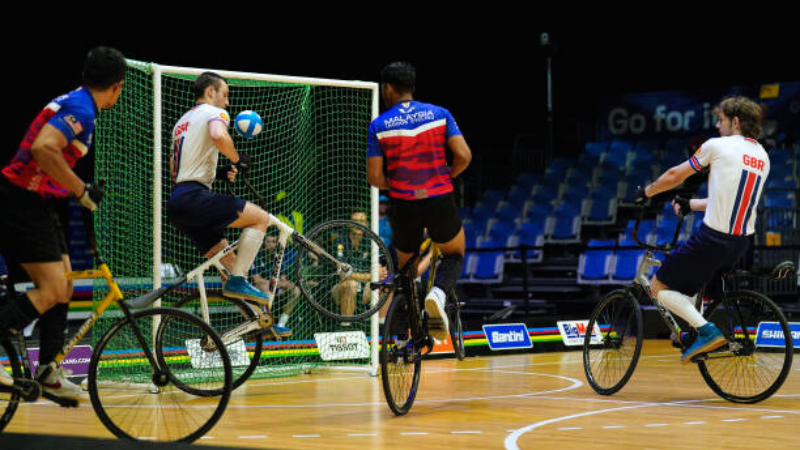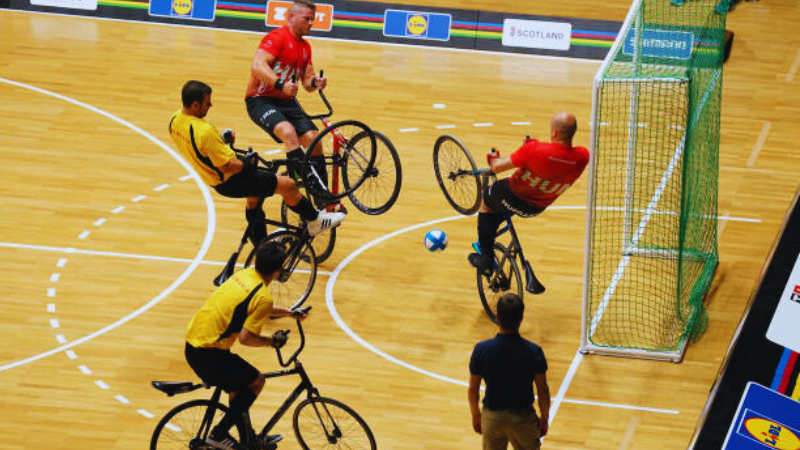Cycle ball is a fun team sport that mixes bike football and cycling. Instead of horses, players ride bikes and try to hit a ball into the other team’s goal. It’s fast-paced and exciting!
In this article, we’ll discuss about cycle football, how to play bike football, and its rules.
Are Cycle Ball and Bike Football the Same?
Cycle ball, also known as radball, cycle soccer, or bike football, is an attractive and unique sport that combines elements of football (soccer) and cycling.
Players compete on bicycles within a compact, enclosed area, aiming to score goals by maneuvering a ball with their wheels. It is a dynamic game with a loyal following around the world.

Cycle Ball Rules
The game involves two teams of two players maneuvering bicycles around the pitch and trying to score goals using a small white ball. Let’s take a closer look at the cycle ball rules:
Team
In bike football, each team typically consists of two players. So, a total of four players are on the court during a game of bike football.
Field Size
The playing area is 14 meters long and 11 meters wide, surrounded by boards that are 30 centimeters tall. The goal is 2 meters wide and 2 meters tall.
Playing Time
A cycle ball match is divided into two halves, each lasting 7 minutes with a 90-second halftime break. This brief intermission allows players to catch their breath, strategize, and recharge for the intense and action-packed gameplay that follows.
Bike
Because of a strong frame, the bike stays stable. It has a fixed gear, so you can balance on one spot and move forward or backward. The bike weighs around 13 kg. Players sit on the bike like on a luggage rack to shift weight better. The handlebar shape lets players do cool tricks with the ball.
Ball
It’s a tough ball made of fabric and filled with horsehair, not inflatable. It’s about 17 cm wide and weighs around 550 grams. When players kick it for attack, it can zoom at speeds up to 70 km/h!
Gameplay
Players can shoot using either the front or back wheel of the bike, and they can even use their heads to hit the ball. However, they can’t use their hands. The goalkeeper inside the penalty area can use their hands to defend the goal.
Touching the floor is not allowed during play. If a player touches the floor, they have to go behind their own goal line before they can join in again. The referee stays on the ground during the game. Breaking the rules or fouls result in either a free kick or a penalty taken from a distance of 4 meters. Goals are often scored from corner kicks.
Fouls
Like any sport, cycle ball has rules governing player conduct. Fouls in this sport include hitting an opponent, striking the ball out of bounds, and using one’s body to impede the ball’s progress. When a foul occurs, the opposing team is awarded a free hit or penalty, depending on the severity of the infraction.
Player Classification
Players are classified into four different divisions based on their skill level:
- Division A: The highest level of play, reserved for experienced players.
- Division B: For players with intermediate skills.
- Division C: For beginner players.
- Division D: For players new to the sport.
Tournaments
Cycle ball tournaments are held all over the world, with the most prestigious event being the World Championships. The World Championships are held every four years, and they attract the top players from around the globe.

Benefits of Bike Football
Find out some pros about bike football:
Low Impact: Compared to traditional soccer, cycle soccer is a low-impact sport. The bikes used have a fixed gear and no brakes, meaning collisions between players are less forceful, reducing the risk of injury.
Coordination and Balance: Cycle soccer requires a high level of coordination and balance from players as they navigate the field on their bikes while controlling the ball. This aspect of the sport promotes physical fitness and improves motor skills.
Accessibility: Cycle soccer is accessible to people of all ages and skill levels. Since the game is played on bikes rather than relying solely on running ability, individuals with varying physical abilities can participate and enjoy the sport.
Environmental Benefits: The bicycle is an environmentally friendly means of transport, and its inclusion in a sport like cycling football promotes sustainability. By encouraging physical activity through cycling, the sport makes a positive contribution to both personal health and the environment.
Community: Cycle football promotes community among players and enthusiasts. Whether playing casually with friends or participating in organised leagues, the sport brings people together, fostering camaraderie and teamwork.
History of Cycle Soccer
The origins of the cycle ball date back to the late 19th century in Europe, particularly in Germany and Czechoslovakia. Originally invented as an off-season pastime for cyclists, cycle soccer quickly developed into a structured sport with its own rules and competitions.
One of the key moments in the history of cycling was the foundation of the Union Cycliste Internationale (UCI) in 1900, which made it possible to organise and develop the sport. With the development of cycling technology and the growing interest in cycling, cycle soccer has become a popular spectator sport, especially in European countries such as Germany, Switzerland, and Austria.
At the beginning of the 20th century, official cycling ball competitions and leagues were established, and national championships were held in various countries. These events attracted experienced athletes and passionate enthusiasts, contributing to the sport’s development and awareness.
In 1929, the first international cycling ball tournament was held in Paris, which was a milestone in the globalisation of the sport. The following decades, cycling ball continued to evolve, with changes in equipment, playing techniques and rules allowing the game to be refined to its modern form.
In the mid-20th century, the popularity of bike football reached its zenith, with packed arenas and enthusiastic crowds cheering on their favourite teams. However, as other sports became more popular and public interests changed, participation and public interest in cyclical ball fluctuated.
Despite these difficulties, cycling has survived, driven by the dedication of players, coaches, and supporters around the world. Today, the sport has a vibrant community of enthusiasts, with competitions ranging from local tournaments to international championships.
Conclusion
Cycle ball promotes coordination, balance, and teamwork and is suitable for people of all ages. Tournaments like the World Championships bring out the best players, which helps foster a sense of community between the participants.
All in all, cycling ball is enjoyable, improves physical fitness, and brings friendship to enthusiasts around the world.